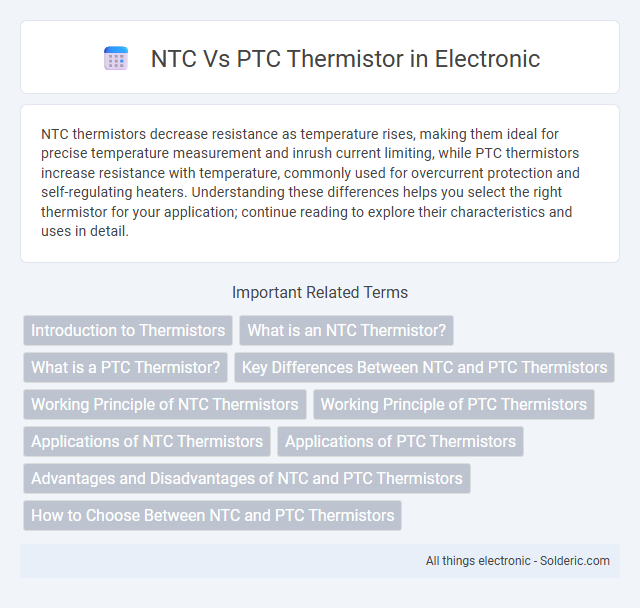NTC thermistors decrease resistance as temperature rises, making them ideal for precise temperature measurement and inrush current limiting, while PTC thermistors increase resistance with temperature, commonly used for overcurrent protection and self-regulating heaters. Understanding these differences helps you select the right thermistor for your application; continue reading to explore their characteristics and uses in detail.
Comparison Table
| Feature | NTC Thermistor | PTC Thermistor |
|---|---|---|
| Full Form | Negative Temperature Coefficient | Positive Temperature Coefficient |
| Resistance-Temperature Relationship | Resistance decreases as temperature rises | Resistance increases as temperature rises |
| Common Uses | Temperature sensing, inrush current limiting | Overcurrent protection, self-regulating heaters |
| Response Time | Generally faster response time | Slower response time compared to NTC |
| Temperature Range | Typically -55degC to 150degC | Typically -40degC to 125degC |
| Material Composition | Ceramic metal oxides (e.g., manganese, cobalt) | Polycrystalline ceramic materials |
| Cost | Usually lower cost | Generally higher cost |
| Stability | Less stable over time and temperature cycling | More stable over time and temperature cycling |
Introduction to Thermistors
Thermistors are temperature-sensitive resistors that change resistance with temperature variations, commonly classified as Negative Temperature Coefficient (NTC) or Positive Temperature Coefficient (PTC). NTC thermistors decrease resistance as temperature rises, making them ideal for temperature sensing and inrush current limiting. PTC thermistors increase resistance with temperature, often used for overcurrent protection and self-regulating heating elements to safeguard your devices.
What is an NTC Thermistor?
An NTC thermistor (Negative Temperature Coefficient) is a temperature-sensing device whose resistance decreases as the temperature rises, making it ideal for precise temperature measurements and compensation. Unlike PTC thermistors, which increase in resistance with temperature, NTC thermistors provide rapid response times and high sensitivity in temperature detection applications such as circuit protection and temperature monitoring. If you need accurate temperature readings, understanding how your NTC thermistor operates can enhance your device's efficiency and safety.
What is a PTC Thermistor?
A PTC thermistor is a type of resistor that increases its resistance as temperature rises, making it ideal for overcurrent protection and self-regulating heating applications. Unlike NTC thermistors, which decrease resistance with temperature, PTC thermistors provide a positive temperature coefficient, enabling them to act as resettable fuses in electronic circuits. Their material composition typically includes doped polycrystalline ceramic, which ensures stable and reliable performance under varying thermal conditions.
Key Differences Between NTC and PTC Thermistors
NTC thermistors exhibit a decrease in resistance as temperature rises, making them ideal for temperature sensing and inrush current limiting applications. PTC thermistors, conversely, show an increase in resistance with rising temperature, commonly used for overcurrent protection and self-regulating heating elements. The distinctive resistance-temperature relationship and application areas define the primary operational differences between NTC and PTC thermistors.
Working Principle of NTC Thermistors
NTC thermistors operate based on the principle that their resistance decreases as temperature increases, allowing precise temperature measurement and control. These thermistors are made from semiconductor materials whose charge carrier density rises with heat, reducing electrical resistance. Your applications benefit from their rapid response and accuracy in temperature sensing and protection circuits.
Working Principle of PTC Thermistors
PTC thermistors work based on a positive temperature coefficient, where their resistance increases significantly with rising temperature, creating a self-regulating effect. When the temperature reaches a certain threshold, the PTC material transitions from a low-resistance to a high-resistance state, limiting current flow and protecting circuits from overheating. This thermal-sensitive behavior makes PTC thermistors ideal for overcurrent protection and temperature sensing applications.
Applications of NTC Thermistors
NTC thermistors are widely used in temperature sensing applications such as digital thermometers, HVAC systems, and battery management for precise temperature monitoring. Their rapid response to temperature changes enables accurate control in refrigeration units, automotive engine management, and medical devices. You can rely on NTC thermistors for real-time temperature regulation in consumer electronics and industrial equipment.
Applications of PTC Thermistors
PTC thermistors are widely used in overcurrent protection devices, self-regulating heating elements, and temperature sensing applications due to their positive temperature coefficient of resistance. Their ability to increase resistance sharply at a certain temperature makes them ideal for circuit protection and resettable fuses, preventing damage to electrical equipment. Your safety devices and temperature control systems can greatly benefit from the reliable response characteristics of PTC thermistors.
Advantages and Disadvantages of NTC and PTC Thermistors
NTC thermistors offer high sensitivity and fast response for temperature measurement, making them ideal for precise temperature control, but they have a limited temperature range and non-linear resistance change, which can complicate calibration. PTC thermistors provide inherent overcurrent protection and self-regulating heating, enhancing device safety and reliability, but they exhibit lower sensitivity and slower response times compared to NTC types. Understanding the advantages and disadvantages of NTC versus PTC thermistors helps you select the best component for accurate temperature sensing or circuit protection applications.
How to Choose Between NTC and PTC Thermistors
Choosing between NTC and PTC thermistors depends on the specific temperature sensing or protection requirements of the application. NTC thermistors are ideal for precise temperature measurement and temperature compensation due to their predictable decrease in resistance as temperature rises, whereas PTC thermistors are more suitable for overcurrent protection and self-regulating heating elements because their resistance increases sharply at a certain threshold temperature. Evaluating the operating temperature range, response time, and intended function helps determine the most effective thermistor type for a given electronic or electrical system.
NTC vs PTC thermistor Infographic

 solderic.com
solderic.com